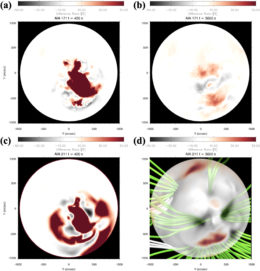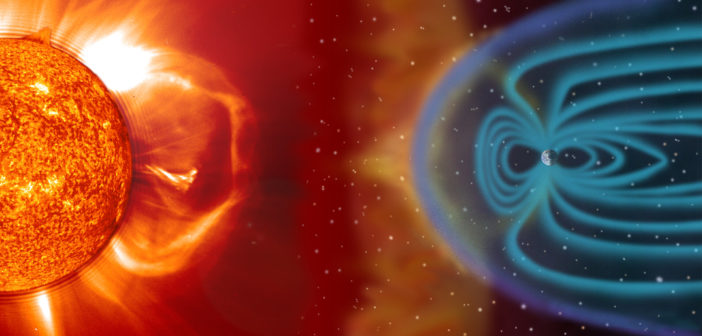Are there any indications as to when monster solar storms are going to happen? A team of astronomers used simulations combined with observations of our home star to show that we may have another way to tell when these massive events are coming toward us.
An Active Atmosphere of a Seemingly Serene Star
Space weather, particularly solar flares and coronal mass ejections (CMEs), have a direct impact on life here on Earth. Though our world is protected by the blanket of Earth’s magnetic field, if a solar storm is energetic enough, it can damage weather satellites, GPS satellites, and knock out power grids. Therefore, understanding these events is crucial to maintaining daily life in a world dependent on these technologies.

Two dimming/brightening events with the difference between the base image and the observation shown by the color scale (dimmer than the original event shown in black and brighter shown in red). [Adapted from Jin et al. 2022]
An AWSoM Simulation of the Sun
The team used the Alfvén Wave Solar Model (AWSoM) to reconstruct the Sun’s corona and the solar wind environment and then simulated CMEs with various characteristics, such as speed, mass, and magnetic energy. These CMEs are initiated by magnetic flux ropes erupting from the surface. Jin and collaborators also looked at observations of the dimming events from the Atmospheric Imaging Assembly and the Extreme Ultraviolet Variability Experiment, which are part of the Solar Dynamics Observatory.

Two of the authors’ simulations of the Sun. The difference between the base image and the observation is shown by the color scale (dimmer than the original event shown in black and brighter shown in red) and field lines shown in white and green on Panel (d). [Jin et al. 2022]
Magnetospheric Modeling and Coronal Construction
The authors’ models were able to reproduce many features observed in the coronal dimming that followed a CME eruption, which shows that dimmings can help us understand characteristics of the associated CMEs such as their energy, mass, and the magnetic configuration of the flux ropes that caused them. Using that knowledge, the team deduced that transient brightening and dimming patterns are related to plasma heating processes in the corona, while long-lasting core and remote dimmings (which are away from the source region) are caused by mass loss from CMEs. They also found that the coronal dimming patterns are significantly influenced by the interaction between the erupting flux ropes with different orientations and the solar corona as a whole.

A cartoon showing the location of CMEs and magnetic field lines in relation to dimming spots. [Adapted from Jin et al. 2022]
This knowledge about the relationship between coronal dimmings and solar CMEs could also help us detect CMEs on stars outside of the solar system! Distinguishing between stellar flares and CMEs is difficult but important when considering habitability because CMEs are more likely to erode planetary atmospheres. With knowledge that CMEs are associated with stellar dimmings, we can get a better handle on which stars have CMEs, and therefore better judge which planets may be habitable.
Citation
“Coronal Mass Ejections and Dimmings: A Comparative Study Using MHD Simulations and SDO Observations,” Meng Jin et al 2022 ApJ 928 154. doi:10.3847/1538-4357/ac589
